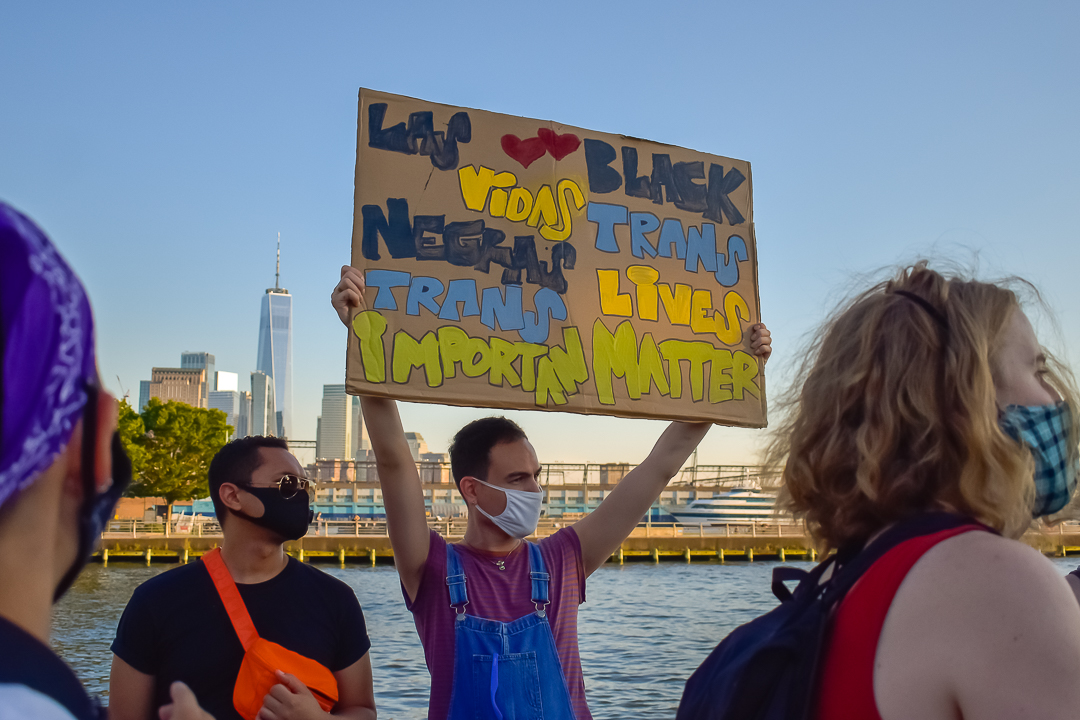

Trans activists gathered in Pier 45 in Greenwich Village on July 31 to fight against violence (Diego Jesús Bartesaghi Mena/Latino Rebels)
NEW YORK — In the early hours of July 26, Tiffany Harris was found unconscious with a stab wound to the chest in the third-floor hallway of a building on Jerome Avenue, in the Fordham Manor section of The Bronx. Harris was pronounced dead later hours later. The next day Queasha Hardy was found shot to death on a street in Baton Rouge, La. Hardy was pronounced dead at the scene.
These cases have two things in common: both of them were transgender women of color, and in both cases the suspect hasn’t been apprehended.
This year alone there has been at least 25 deaths of transgender or gender non-conforming people, according to a report from the Human Rights Campaign (HRC). It is the highest number reported since 2003, the first year the HRC began tracking these incidents.
Amid the increase of deaths of transgender women of color, the Street Transvestite Action for Radical Reform (STARR) —considered the oldest radical trans rights group in the United States founded in 1970 by the legendary trans and gay rights pioneers Sylvia Rivera and Marsha P. Johnson— hosted a rally on Friday, July 31 at Pier 45 in Greenwich Village against trans violence.
“We are gathering today to remember the lives of the trans Black women who have died in the hands of bigotry, racism, discrimination, and misogyny,” said Mariah López, Executive Director of STARR. “Enough is enough!”


Mariah López, Executive Director of STARR, raises her fist as sign of Trans power (Diego Jesús Bartesaghi Mena/Latino Rebels)
Pier 45 has been an important place in queer history—becoming a safe haven, and first or second homes, for queer and trans people of color since the 1930s. Johnson and Rivera established a presence in the area, providing food and clothing to the youth living there. Many trans women walk the piers in search of johns. It was also where Johnson’s body was found floating at the end of the block in 1992.
“We are standing on sacred grounds historically occupied by Black and Brown queer people,” said Elisa Crespo, education liaison at the Bronx Borough President’s office, becoming the first openly transgender woman of color to work for a Bronx-wide office.
“When we getting attacked from the highest levels of government, from the Trump administration, we have a problem. When trans women are twice as likely to live under the federal poverty line, we have a problem in our hands,” Crespo said. “They don’t want us to be united because they understand the power we have.”
According to research conducted by UCLA, 48.4% of Hispanic transgender people and 38.5% of Black transgender people live under poverty.
Moreover, 69.3% of sex workers reported being denied a job or getting fired because of their gender identity or expression. In addition, 19.9% were almost three times as likely to engage in the sex trade as means of survival, according to a 2015 report.
“We are in the midst of a public health crisis. They are killing Black trans women in a disproportional rate,” said Gia Love, a model and Director of Community Engagement from Black Trans Femmes in the Arts. “We are important and our voices need to be heard.”
The violence against trans women can also be traced on how the media have been portraying this community.
For example, since 2002, the Gay & Lesbian Alliance Against Defamation (GLAAD) cataloged 102 episodes and non-recurring storylines of scripted television that contained transgender characters, and found that 54% of those were categorized as containing negative representations at the time of their airing. An additional 35% were categorized at ranging from “problematic” to “good,” while only 12% were considered ground-breaking, fair and accurate enough.
Moreover, misgendering and misrepresentation when reporting trans issues are far too common in news outlets when local reporting uses the name on their birth certificate rather than their preferred name as well the wrong pronoun. Leaving out these basic facts about their identities is a form of erasure.


An allied holding a sign that reads: Las Vidas Negras Trans Important; Black Trans Lives Matter (Diego Jesús Bartesaghi Mena/Latino Rebels)
“The media portray us as thugs, that we want to burn stuff. The only thing I want to burn is your system,” said Alana Jessica, trans activist and actress from the hit TV show Pose and Tales of the City. “A Black trans woman is the only person who knows what is like to fight racism, misogyny, transphobia and underlying homophobia. We have different movements for all of these things separately. Imagine feeling all those combine every fucking day while walking these streets.”
The rally against trans violence, which lasted more than three hours and gathered several allies, became a safe place for other trans women of color to be accepted in a society that doesn’t accept them, to be embraced by the only community that supports them, and to have a voice against the violence they encounter every day.
***
Diego Jesús Bartesaghi Mena is a 2020 Latino Rebels summer correspondent. A recent graduate of Columbia Journalism School, he is based in Newark, NJ and tweets from @bartesaghi_mena.


